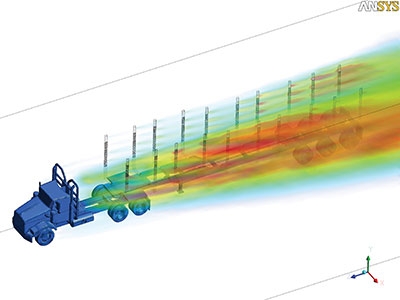
Features
Harvesting
Transportation
Reducing drag
Feb. 17, 2014 - Could it be that forest companies and racing car teams are waging the same battle? At first glance, no, since both industries have little in common apart from their focus on the performance of very powerful machines. A research group at FPInnovations, however, believes that forest companies could benefit from some of the expertise surrounding the high-speed spectator sport, especially when it comes to aerodynamics. Using the science of fluid mechanics, the impact of the shape of a race car’s exterior, components can be modelled to see how to increase fuel efficiency. When will a logging truck be on the podium for energy performance?
Thousands of trucks travel on forest roads and highways across Canada, with loaded and unloaded log trailers, during forest operations or on their way to supply mills. Transport can account for up to half of the delivered wood costs for the forest industry. The 2.7 billion litres of fuel consumed annually by the Canadian forest industry are the equivalent of over 7.3 million tonnes of greenhouse gases. Year after year, resources are transported over increasingly longer distances to be sold or processed. As a result, transport-related activities are applying greater pressure on both the Canadian industry’s competitiveness and the life cycle of forest products. Add to that rising fuel prices and a desire to reduce the environmental footprint and you have companies that would gain by learning more about fuel-efficient operating practices and technologies. One of the main contributing factors to the fuel consumption of these vehicles, i.e. between 40 and 50 per cent of total consumption, is aerodynamic drag.
Over the years, the FPInnovations research team responsible for transport and energy efficiency has developed a comprehensive toolbox to measure and analyze the impact of a truck’s profile on aerodynamic drag. It is therefore possible to compare various configurations and different products for logging trailers.
Analysis toolbox
The importance of the approach taken by the group at FPInnovations is the potential for developing specific technological solutions. To achieve that, the group’s focus is twofold – identify the best technologies for reducing aerodynamic drag and identify those for reducing the impacts of various trailer configurations.
The group relies on a whole array of equipment primarily to conduct three types of tests. Modelling using computational fluid dynamics (CFD) makes it possible to visualize the air flow and turbulence around a truck and its trailer. Modelling with CFD allows several concepts and products to be tested quickly and economically. Simulations of the most promising products are then calibrated using wind tunnel tests for a second sorting and are finally evaluated with track tests that may be costly but better reflect on-road operations. A wide variety of devices available on the market can therefore be tested and sorted by the first two methods to better understand and compare the aerodynamic drag created by the different products. Then, the most promising product is track tested.
Benefits of improved aerodynamics
A trend seen in the industry is that forest companies with tree-length systems are increasingly adopting felling-processing as their harvesting method. Trailers used in these cases are equipped with several stakes to retain the multiple bundles of shortwood produced by this type of harvesting.
Simulations and wind tunnel tests have demonstrated that by simply removing the stakes, once the trucks have been unloaded, aerodynamic drag may be reduced by 35 per cent. Track tests showed 15 per cent less fuel was consumed. This fuel economy could translate into annual savings of $2,500 to $4,500 per truck. The stakes, however, must be back in place to hold the logs during the next loaded trip. Some manufacturers therefore offer foldable stakes or others that lie flat on the platform. Savings then depend on the added weight of these motorized or mechanical stake folding systems.
The trucking industry could expect to enjoy even more savings by using the right configurations and combinations of technologies. The logging truck of the future will therefore be equipped with good deflectors, strategically installed at the right place on the roof and behind the driver’s cab, and having the optimal deflection angle. The truck will then be able to reach the podium.
For further information, please contact Jan Michaelsen at 514-782-4524 or jan.michaelsen@fpinnovations.ca.
February 17, 2014 By Jean-Luc Bernier
 Simulations and wind tunnel tests have demonstrated that by simply removing the stakes Could it be that forest companies and racing car teams are waging the same battle?
Simulations and wind tunnel tests have demonstrated that by simply removing the stakes Could it be that forest companies and racing car teams are waging the same battle?Print this page